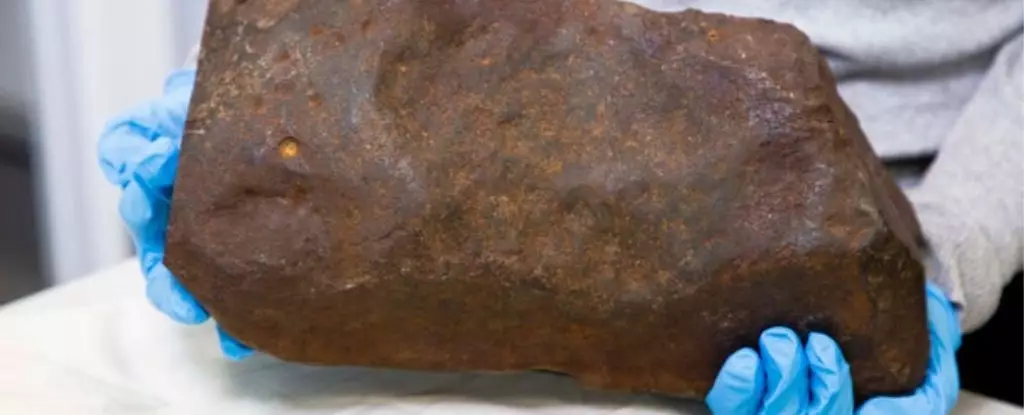In 2015, an ordinary day of metal detecting transformed into an extraordinary episode in the life of David Hole. As he roamed the grounds of Maryborough Regional Park in Victoria, Australia, he stumbled upon a dense, reddish rock embedded in yellow clay. Initially, he believed he had struck gold—a sentiment not uncommon in this historic Goldfields region known for its rich mining history during the 19th-century Australian gold rush. What unfolded over the coming years, however, would reveal not a glimmering nugget of riches but an incredible piece of extraterrestrial history.
Equipped with tools more suited for breaking up rocks than unearthing ancient mysteries, Hole embarked on a quest to reveal the secret within this heavy find. His efforts included an array of methods from rock saws and angle grinders to a sledgehammer, making the beleaguered rock the subject of both frustration and fascination. None of these efforts bore fruit; the object remained resolutely intact, resisting all attempts at investigation. Eventually, curiosity led Hole to present his mighty rock to the experts at the Melbourne Museum. Little did he know, he was about to uncover a celestial treasure.
The rock’s eventual fate took a significant turn when it caught the attention of geologist Dermot Henry. Known for his extensive expertise—spanning 37 years and countless rock evaluations—Henry approached Hole’s find with cautious optimism. “I’ve seen tons of rocks that people mistakenly identify as meteorites,” Henry reflected, acknowledging the difficult nature of differentiating mundane stones from their cosmic counterparts. After some inquiry and examination, it turned out that Hole’s rock was, in fact, a rare meteorite, identified as the second-largest chondritic mass in Victoria to date.
Laboratory analysis revealed the meteorite, which was named “Maryborough” after its discovery site, weighed an astonishing 17 kilograms (37.5 pounds) and was composed of a high percentage of iron, categorizing it as an H5 ordinary chondrite. These types of meteorites are characterized by their creation process, which involves the cooling and solidification of molten materials in the early solar system. It was a time capsule encapsulating phenomena that occurred over 4.6 billion years ago, when our solar system began to take shape.
While many consider gold the ultimate symbol of wealth, this meteorite offers a different perspective on value. Henry distinguished the scarcity and scientific importance of the Maryborough meteorite against the backdrop of countless gold nuggets unearthed throughout Victoria. Indeed, only 17 meteorites have ever been recorded in this Australian state, a stark contrast to the thousands of gold discoveries. “In terms of scientific research, this meteorite is far more valuable than any gold nugget,” Henry stated emphatically.
Delving deeper into the implications of such findings, Henry noted that meteorites serve as natural archives of our solar system’s history. They not only convey information about the planets and their formation but also provide clues on the evolution of the Earth itself. Some meteorites even harbor primordial materials like stardust, pushing the boundaries of our understanding of cosmic development and the conditions that led to life’s inception on Earth.
Investigations into the origins of the Maryborough meteorite suggest that it may have originated from the asteroid belt between Mars and Jupiter—a region teeming with remnants from the early solar system. Various cosmic collisions may have nudged it from its original course, ultimately guiding it on a path that would end in our backyard. The estimated time it has spent on Earth ranges from 100 to 1,000 years, briefly intersecting our modern timeline with its storied past.
As scientists aim to decode its history, one cannot ignore the improbable nature of its discovery. The odds of stumbling upon such a rare artifact are, in fact, astronomical. Every once in a while, the universe conspires to maintain a connection between its past and our present.
The captivating saga of the Maryborough meteorite is an invitation to reconsider what lies beneath our feet. Perhaps it is time we take a second glance at our surroundings, to embrace curiosity and uncover potential cosmic treasures that may be waiting to be found. As enthusiasts sift through their backyards or parks with metal detectors, they might just be sitting on their own metaphorical gold mine—one that could provide insights both earthly and cosmic.
In a world where many treasures are hidden, the discovery of the Maryborough meteorite encapsulates the thrill of exploration, the beauty of scientific inquiry, and the profound secrets that the universe may hold—all waiting to be uncovered by the persistent and the curious.


Leave a Reply